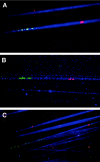An optimized set of human telomere clones for studying telomere integrity and architecture
- PMID: 10869233
- PMCID: PMC1287181
- DOI: 10.1086/302998
An optimized set of human telomere clones for studying telomere integrity and architecture
Abstract
Telomere-specific clones are a valuable resource for the characterization of chromosomal rearrangements. We previously reported a first-generation set of human telomere probes consisting of 34 genomic clones, which were a known distance from the end of the chromosome ( approximately 300 kb), and 7 clones corresponding to the most distal markers on the integrated genetic/physical map (1p, 5p, 6p, 9p, 12p, 15q, and 20q). Subsequently, this resource has been optimized and completed: the size of the genomic clones has been expanded to a target size of 100-200 kb, which is optimal for use in genome-scanning methodologies, and additional probes for the remaining seven telomeres have been identified. For each clone we give an associated mapped sequence-tagged site and provide distances from the telomere estimated using a combination of fiberFISH, interphase FISH, sequence analysis, and radiation-hybrid mapping. This updated set of telomeric clones is an invaluable resource for clinical diagnosis and represents an important contribution to genetic and physical mapping efforts aimed at telomeric regions.
Figures




References
Electronic-Database Information
-
- Bacpac Web site, http://www.chori.org/bacpac/home.htm
-
- Comprehensive genetic map, http://www.marshmed.org/genetics/ (for distal marker identification)
-
- GenBank, http://www.ncbi.nlm.gov/Genbank/GenbankSearch.html (for primers and sequence information)
-
- Généthon map, http://www.genethon.fr/genethon_en.html (for distal marker identification)
-
- Genome Database, http://gdbwww.gdb.org/ (for primer information)
References
-
- Ashworth LK, Batzer MA, Brandriff B, Branscomb E, de Jong P, Garcia E, Garnes JA, et al (1995) An integrated metric physical map of human chromosome 19. Nat Genet 11:422–427 - PubMed
-
- Brown WRA (1989) Molecular cloning of human telomeres in yeast. Nature 338:774–776 - PubMed
-
- Brown WRA, MacKinnon PJ, Villasanté A, Spurr N, Buckle VJ, Dodson MJ (1990) Structure and polymorphism of human telomere-associated DNA. Cell 63:119–132 - PubMed
-
- Buckle VJ, Rack K (1993) Fluorescent in situ hybridization. In: Davies KE (ed) Human genetic diseases: a practical approach. IRL Press, Oxford, pp 59–80
Publication types
MeSH terms
Substances
Grants and funding
LinkOut - more resources
Full Text Sources
Other Literature Sources
Research Materials

